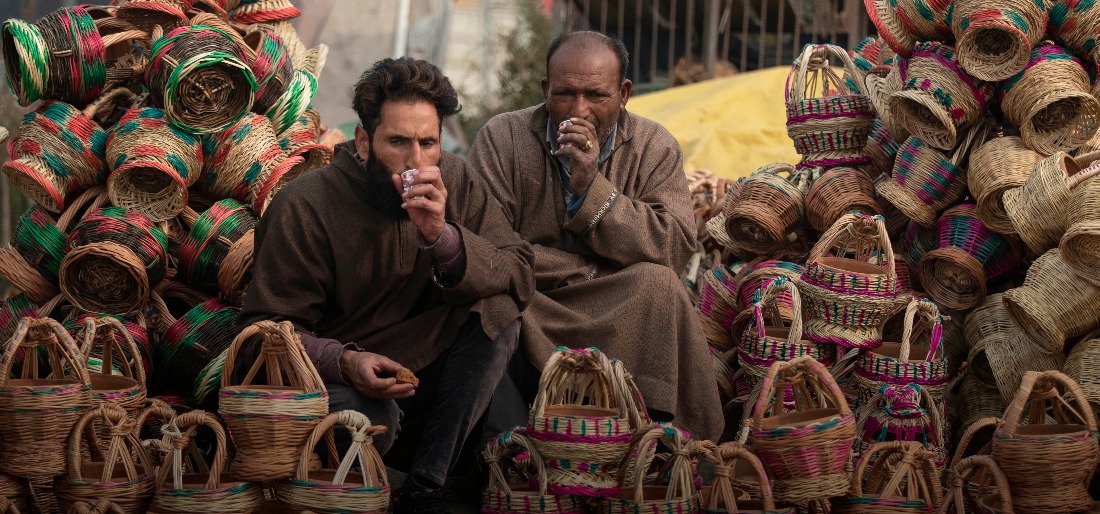Kangris Face Decline in Demand
Climate Change Impacts Winter Culture in Kashmir
Suhail Khan
In Kashmir, where winters are known for their harshness, a shift in climate patterns is reshaping age-old traditions. The 40-day period of ‘Chilai Kalaan,’ marked by bone-chilling temperatures, typically sees Kashmiris relying on the traditional fire pot known as the “kangri” to stave off the cold. However, this winter, the familiar sight of locals carrying kangris during the day is notably absent.
- Kangri is an earthen pot woven around with wicker filled with hot hot embers keep the people warm in these chilly winter days.
- Making of kangri in Kashmir regarded as a work of art.
- People kept it inside the Pheran (traditional woolen cloak worn) normally, or inside a blanket.It is about 6 inches (150 mm) in diameter and reaches a temperature of about 150 °F (66 °C).
- The maker makes Kangri in assorted types, small ones for children and large ones for adults.
- History revealed that Kashmir’s learnt the use of the kangri from the Italians .
Local residents talking to Kashmir Despatch said that the rise in temperatures has rendered the use of kangris unnecessary during daylight hours.
Tanveer Ahmed, a resident of Sopore, told KD that this winter so far has been quite different from what we used to witness in Kashmir. He said, “Earlier this month, it was 12°C here in Baramulla. The same was in Jammu and Delhi. So there was really no need for a Kangri during the day. Even with the good temperature during the day, people hardly use kangris .”
He expressed concerns about the impact of global warming on the valley’s climate. This winter, the Kashmir valley has experienced an unusual absence of snowfall during the traditionally harshest phase of winter.
Experts warn that if this pattern persists, it could pose challenges for the agricultural and horticulture sectors, as well as have a greater impact on winter tourism in the valley, which has already been suffering for the past month due to the lack of snow.
Ishfaq Ahmad, a Kangri maker from Nadihal village in Baramulla, told Kashmir Despatch over the phone about his perspective on the changing trends. He revealed that this winter has not been good for business, with rising temperatures diminishing the demand for Kangris.
He said, “Usually, I sell over 200 Kangris in a season, which helps me earn more than ₹50,000. However, this year, sales have taken a considerable dip.”
RELATED ARTICLE:Young Boy Passes Away in Sleep Due to Electric Blanket- Remember These Safety Measures During Winter
KANGRIS FACE DECLINE
Describing the intricate process of making kangris, Ishfaq explained that it begins in autumn with the collection of wicker sticks from forests and fields. The sticks undergo a labor-intensive process, involving boiling, peeling, and drying.
Craftsmen then weave the prepared sticks around an earthen pot to create the traditional Kangri. The cost of a Kangri varies based on the process and materials used, ranging from ₹250 to ₹1,500.

Ishfaq further said that the popularity of fashionable Kangris, which are sold for higher prices, attracts tourists and individuals looking to adorn their homes or present them as gifts.
Kaiser Ahmed, a Kangri maker from Botingoo village in north Kashmir, told Kashmir Despatch that this winter so far has been really hard for us because the demand for Kangris has gone down with the rising temperatures during the day. He said, “Even our stock, which is stuck at home due to no sales, because the market is nowhere with no snow anywhere in Kashmir.”
He said, “What can we say? We are only hopeful and pray to Almighty that it should snow soon, at least we could be able to sell our stored sales.”
Meanwhile, the Meteorological Department has predicted light snow at isolated higher reaches of Kashmir from January 25 and it may continue for the subsequent two days.
Willow is mainly used to make baskets, kangri and ornaments which are usually presented as gifts on weddings, anniversaries and other occasions which also highlights Kashmiri culture.
RECENT POSTS: